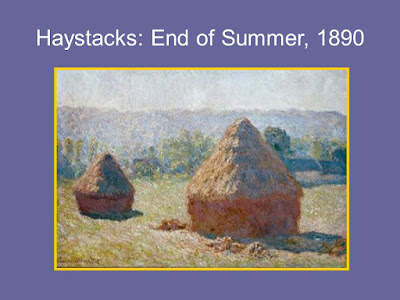Claude Monet
1840-1926
This photo was taken only 3 months before Claude Monet passes away. Although his sight was limited because of cataracts he still painted until he died in 1926.
Monet loved to paint the effect of light on a subject rather than the subject itself. Here we see early morning light on water. Water was one of Monet's favorite subjects. This painting gave impressionism its name. A journalist actually made fun of the painting, because it was not a complete painting it was only an "impression". Despite this insult, Monet and his friends continued to exhibit their paintings. It would be ten years of ridicule and meager sales before impressionism became popular.
Notice how the paint is applied in dots and dashes-an impressionists hallmark.
Another Monet's favorite subjects; flowers, especially poppies. The boy in the foreground is his son, Jean. This painting is composed of colors, rather than forms. The lightness of the two puffy clouds is balanced by the pair of dark trees. The stretch of yellow sunshine against the grey line of the distant hills weights the right half of the picture (remember Leonardo how he painted the blue landscape in the distance also?). And Jean, surrounded by the bright flashes of red poppies brings the viewer's eye full circle.
Monet did not make his pictures like Leonardo, sketching out each section and practicing form and placement. He quickly filled the entire canvas with tones, dabbing color everywhere and filling in the details as he went.
Rather than paint staged pictures of historical or biblical subjects, the impressionist painted the every day world around them. Newly popular steam trains and the great glass architecture of the stations fascinated Monet, especially the effect of light on the steam. Monet painted this station and its trains every day for 3 months, his first "series". You can still take the train to Givenry from this station.
What draws your eye upwards? -peak of roof, steam. What balances it on the bottom?-dark color, solid form, tint vs. shade. What forms are repeated here?-circles, rectangles, organic and geometric forms. What keeps your eyes from wandering outside the station?- big puff of smoke. Where have we seen these clouds before?- previous painting also Leonardo's work.
In the Haystack series, Monet sought to show the changes of light and atmosphere in each one. What time of day do you think this is?- Sunset. What kind of weather? Describe what is different about this painting compared with the train painting. Subject, choice of color, choppier brushstrokes, no atmosphere.
Light radiates softly behind the hay, lighting the hills, trees, houses and fields. The peak of the haystack looks as if it is melting.
Monet paid the farmer to leave the haystacks in the fields all winter so he could paint them. Notice how Monet balances the smaller haystack with the same amount and shape of negative space. Are there more tints of shades in this painting?-tints. Are there more warm or cool colors? - cool. Is this what you would expect?
Monet moved to his country home in Giverny, 40 miles from Paris, in 1883. He virtually abandoned scenes of everyday life, to paint his garden and pond or "water landscape". He painted extensive gardens and created a pond with a Japanese footbridge as Japanese art was becoming popular in the late 1800's. This house, pond and garden survives virtually intact today.
You can see the effect of photography (without which impressionism would never have begun) in this work. There are shadows on the path from trees we cannot see, outside the plane.
This painting is probably a detail for Monet's last waterlily series which hangs in the Orangerie Museum in Paris. Monet had a large studio, and as he loses his sight, his canvas grows bigger. His brushstrokes are looser and freer, almost abstract.
Notice the composition of this work. No horizon line, no background, little detail. What gives this painting balance? -equal tones, triangles.
Contrast this painting with the last two. What is the difference? The same? How can you tell Monet did not paint this at the beginning of his career?



















